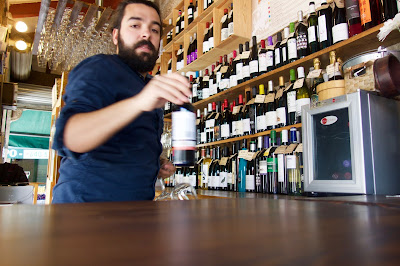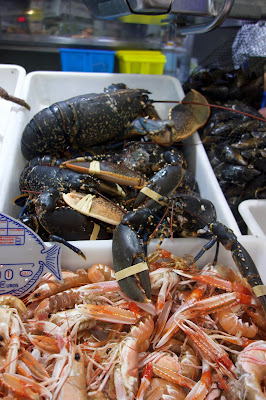Not ashamed to admit my
unabashed love for traditional markets. The
swirls of aromas that awaken the senses, the bustle of people, conversations
that tickle the air like a swarm of temperate bees, the cacophony of delivery trucks
and squeaking carts lazily arriving and departing, the barking of sellers and
serious faces of determined buyers. Sure,
you can find farmers’ markets in the U.S. and they’re fine, but you already
know that’s not the kind of time tested and well worn, town market I’m talking
about. You gotta go to Europe or the
Americas south of Texas to find what I love.
No pretend markets for yours truly.
Gotta be real. Gotta be alive. Gotta have stacks of fresh vegetables and
fruits, flanked by seafood that still carries a hint of salty air and juicy red
meats ready to be cut to your liking.
In the big grocers found on
the corner of in every American city and good-sized town, most of the fish is
frozen. Oranges and lettuce completed
the sea-swaying journey from South America a couple of weeks ago, or longer. All the meats weren’t on the hoof yesterday,
or even last week. Everything is washed,
processed and cellophane wrapped to sterile perfection.
I heard a French wife say she
wouldn’t buy a vegetable that didn’t have dirt on it. I’m with her.
Bring it to me fresh picked and bearing an earthy smell. I’ll do my own washing. Even the eggs. Speaking of which, ever noticed American eggs
need refrigeration and European eggs sit unrefrigerated in paper cartons on
market shelves? Ever wonder why? American eggs MUST be pre-washed and sprayed
with a sanitizer, which takes off a natural coating that protects the egg from
bacteria. European egg farmers don’t
have to do that. Their eggs stay fresh
and impenetrable on your counter top.
Rather than dwell on wash or
don’t wash, you can read the whole story here:
http://www.businessinsider.fr/us/why-europeans-dont-refrigerate-eggs-2014-12/
But, let’s get out of the hen
house and back to markets. In Europe
you’ll discover old stone markets that have stood the test of time and they’re
not just to impress the tourists.
Restaurant chefs, housewives, house husbands, and serious amateur cooks
crowd in, shoulder to shoulder, picking out the best of what the local farmers,
cheese makers, vintners, bakers, pastry makers, fishermen, butchers and herb
and flower growers have to offer. Found
one of those in the heart of Santiago de Compostela, Spain. Mercado de Abastos de Santiago is open Monday
through Saturday, 9 a.m. to 3 p.m. (0900 – 1500).
How old is this place? Looks like a photo of forever and your eyes
don’t deceive. The area’s been a center
of agricultural commerce for over three hundred years. The current group of buildings date to 1941,
but the gray stone-walls sport a patina of historic use.
Ok, I’m a suitcase-toting
tourist, so why would I want to shop at a market? Hey, I bought thick bars of chocolate for hot
chocolate. Spanish hot chocolate is
almost as thick as pudding and American coco is not in the same ballpark, or
the same league. Not even the same game!
Also, as a cook, I shopped for
regional herbs. Living in Europe, I
don’t have to worry about custom officers having a fit over what I’ve purchased
in another part of the EU. Surrounding
the market, other overstuffed stalls offer kitchenware, t-shirts, glassware and
goodness knows what else.
But buying is only a small
part of my market visits. I like to chat
with the locals, ask about recipes for favorite dishes, stop and sip a wine or
three, smell the flowers, watch how the locals interact, grab an offered taste
of this and that. Every vendor I saw in
the Santiago market was happy to whack off a sliver of ham or sausage, slice a
bit of cheese or bread to whet my appetite, or answer questions about agriculture,
or explain the fruits and wines and flowers I’d never seen before.
In a wine stall, I sampled
several vintages and got my eyes and taste buds opened by the wine merchant,
ever so happy to tell me about his products.
The ones I tried were delicious.
Funny thing. He had no wine and beer
license, so he couldn’t sell his juice by the glass, but he offered small
bottles to slake my thirst while we chatted.
A European open market is
truly a place of wonderful discovery and one of the best chances you’ll have to
interact with the locals and even share a laugh or two. Want to find out what real food tastes
like? Let the stall keepers turn you on
to flavors, then eat at a local restaurant.
They all shop here too.
The Santiago central market is
a wonderland of everything a market should be.















Makes you want to live there so you can go there often.
ReplyDelete